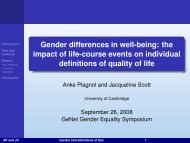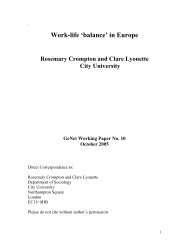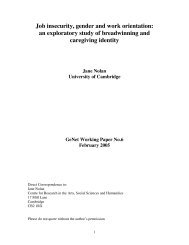Guidelines for Gender Equality Programmes in Science - GeNet
Guidelines for Gender Equality Programmes in Science - GeNet
Guidelines for Gender Equality Programmes in Science - GeNet
You also want an ePaper? Increase the reach of your titles
YUMPU automatically turns print PDFs into web optimized ePapers that Google loves.
cannot but contribute to mak<strong>in</strong>g the<br />
environment less welcom<strong>in</strong>g to women. For<br />
<strong>in</strong>stance, <strong>in</strong> natural sciences women were<br />
only 13.4% of the full professors (grade A) <strong>in</strong><br />
the EU-27 countries <strong>in</strong> 2006, and only 7.2%<br />
<strong>in</strong> eng<strong>in</strong>eer<strong>in</strong>g (European Commission,<br />
2009).<br />
In university departments and public<br />
research <strong>in</strong>stitutions, it has been often<br />
argued that the feel<strong>in</strong>gs of isolation and other<br />
difficulties are due to the fact that a “critical<br />
mass” of women has not been reached.<br />
Even though women’s equal or greater<br />
presence <strong>in</strong> specific fields does not<br />
automatically translate <strong>in</strong>to their obta<strong>in</strong><strong>in</strong>g<br />
leadership positions, without such a “mass” it<br />
is harder to even lay the ground <strong>for</strong> change.<br />
A significant presence of women is, f o r<br />
i n s t a n c e, necessary to press <strong>for</strong> the<br />
<strong>in</strong>troduction of gender studies programmes<br />
( i n d e e d, virtually absent <strong>in</strong> scientific<br />
departments), and also to affirm styles that<br />
are alternative to the typical mascul<strong>in</strong>e<br />
models (Blickenstaff, 2005) and to question<br />
the mascul<strong>in</strong>e symbolic perception of science<br />
(Lagensen, 2007) <strong>in</strong> order to create a more<br />
com<strong>for</strong>table environment <strong>for</strong> women (Gürer &<br />
Camp, 2002). Women’s scarce presence on<br />
the staff of scientific faculties and departments<br />
is also considered a discourag<strong>in</strong>g<br />
factor <strong>for</strong> female students, as has been<br />
demonstrated by several studies tak<strong>in</strong>g <strong>in</strong>to<br />
account the gender composition and atmosphere<br />
<strong>in</strong> the m i c r o - e n v i r o n m e n t s i n<br />
which women students and researchers carry<br />
out their work every day (Sonnert, Fox, &<br />
Adk<strong>in</strong>s, 2007).<br />
In S&T as much as <strong>in</strong> other fields, however,<br />
the need <strong>for</strong> a critical mass seems to be at<br />
odds with the presence of “hidden quotas”.<br />
A German study shows, <strong>for</strong> example, that<br />
there exists a tacit limit to the accepted rate<br />
of women <strong>in</strong> research groups and this results<br />
<strong>in</strong> a “revolv<strong>in</strong>g door” effect. This means that if<br />
<strong>in</strong> a group there is already a 25% rate of<br />
women, the (<strong>in</strong><strong>for</strong>mal) trend is that other<br />
women will ga<strong>in</strong> access only when one of<br />
t h e m quits her position (Allmendiger &<br />
Podsiadlowski, 2001).<br />
Scarcity of women, especially with regard to<br />
senior positions, is often at the orig<strong>in</strong> of the<br />
frequently reported problem of w o m e n ’s<br />
marg<strong>in</strong>ality <strong>in</strong> research networks, which<br />
are ma<strong>in</strong>ly based on <strong>in</strong><strong>for</strong>mal relations (the<br />
so-called old boys networks). This fact results<br />
<strong>in</strong> women’s relative isolation or subord<strong>in</strong>ation.<br />
Activities related to work-life balance<br />
needs and career breaks because of<br />
maternity also undoubtedly have a role <strong>in</strong><br />
reduc<strong>in</strong>g the time devoted by women to<br />
<strong>in</strong><strong>for</strong>mal network<strong>in</strong>g activities. The relative<br />
absence of women <strong>in</strong> relations among fellow<br />
researchers decreases the level of mutual<br />
exchange <strong>in</strong>to departments and deprives<br />
women of basic <strong>in</strong>struments <strong>for</strong> successful<br />
advancement (Gupta, Kemelgor, Fuchs, &<br />
Etzkowitz, 2005).<br />
Work-life issues<br />
In the field of scientific and technological<br />
research, as everywhere else, gendered<br />
social roles as family caregivers obviously<br />
weigh heavily on women. Many studies<br />
highlight the difficulty of balanc<strong>in</strong>g professional<br />
scientific activity (that often also<br />
<strong>in</strong>cludes <strong>in</strong>ternational mobility) with care<br />
responsibilities (European Commission, 2005;<br />
Gupta, Kemelgor, Fuchs, & Etzkowitz, 2005;<br />
Z i m m e r, 2003; Meulders, 2003; Staff o r d ,<br />
1996). This situation gives rise to d e e p<br />
psychological and organisational conflicts<br />
<strong>in</strong> women. Inner conflicts and their effects on<br />
w o m e n ’s scientific careers are particularly<br />
serious also consider<strong>in</strong>g the greater degree of<br />
i n t e r d e p e n d e n c y between life doma<strong>in</strong>s and<br />
career experienced by women with respect to<br />
men (Nazio, 2009; Mart<strong>in</strong>-Garcia, 2009;<br />
Matysiak & Vignoli, 2008).<br />
As a consequence, women may feel <strong>for</strong>ced to<br />
renounce maternity or postpone it <strong>for</strong> a long<br />
time, with all the risks entailed, or to slow<br />
down their research activity, often irreversibly<br />
compromis<strong>in</strong>g their own possibilities of<br />
atta<strong>in</strong><strong>in</strong>g levels of excellence, if not even to<br />
give it up altogether. Often the solution is to<br />
lower one’s own expectations and adapt to<br />
models of “reduced careers” that damage the<br />
potential of the researchers (Cacace &<br />
M a s t r o p i e t r o, 2003).<br />
26






